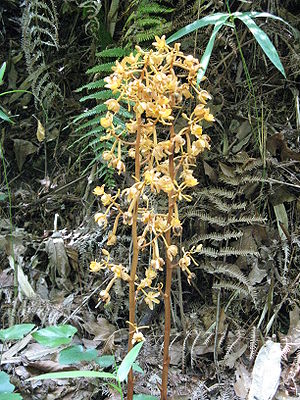Cyrtosia (orchids)
| Cyrtosia | ||||||||||||
|---|---|---|---|---|---|---|---|---|---|---|---|---|

Cyrtosia septentrionalis |
||||||||||||
| Systematics | ||||||||||||
|
||||||||||||
| Scientific name | ||||||||||||
| Cyrtosia | ||||||||||||
| flower |
Cyrtosia is a genus from the family of the orchid (Orchidaceae). It contains six types of herbaceous plants that are native to East and Southeast Asia.
description
The species of the genus Cyrtosia are terrestrial, herbaceous plants. They are leafless and chlorophyllless , they feed on mykoheterotroph . Much of the plant is located underground in the form of a large rhizome with thick, fleshy roots attached to it . The shoot is upright, sometimes branched, covered with papillae , reddish, orange or brown in color. At the nodes are rudimentary leaves that have been reduced to scales.
The shoot ends in a racemose inflorescence . The flowers are resupinated in some species , but not in others. They are usually yellow or light brown, with white or greenish flowers as well. The sepals are fleshy, floured on the outside or hairy. The petals are smaller, thinner in texture, ciliate on the edge in some species. The lip is rounded or indistinctly three-lobed, also occasionally ciliated, the sides are turned up and cling to the column . There is usually a lot of hair on the lip. The column is curved, at the base partially covered with glands, at the top laterally widened ("winged"). The stamen is bent down towards the columnar axis, two-chambered, the two pollinia are of a grainy-powdery consistency. The fruit is fleshy and does not open; So it is, unusual for the capsule- forming orchids, a berry . The fruits are usually red and shiny when ripe. The seeds are also unusual : they are oval, with a hardened seed coat several layers of cells thick . Cyrtosia septentrionalis seeds measure approximately 0.75 × 0.5 millimeters. The seed is completely filled in by a large embryo. Outside, a ring or hinted wing runs around the seed. The seeds of Cyrtosia are likely to spread endozoochorically .
distribution
Cyrtosia is widespread in East Asia. In the north, Japan and Korea are reached, over the southern half of China and rear India the area extends over the islands of Indonesia and the Philippines. A disjoint area is located in Sri Lanka . New Guinea is also populated ( Cyrtosia javanica ).
Systematics and botanical history
Cyrtosia is classified within the subfamily Vanilloideae in the tribe Vanilleae . The next related genera are Erythrorchis and Pseudovanilla .
Cyrtosia was first described by Carl Ludwig Blume in 1825 . The name Cyrtosia comes from the Greek κυρτός kyrtos "curved" and refers to the curved column. Flower declared as type species 1837 Cyrtosia javanica . Bentham and Hooker considered Cyrtosia to be synonymous with Galeola in 1883 . It was not until 1986 that Garay used the name Cyrtosia again and added other species that had previously been named Galeola to this genus.
The following six species belong to the genus Cyrtosia :
- Cyrtosia falconeri (Hook.f.) Aver. : It occurs from the Himalayas to southeastern China and northern Indochina.
- Cyrtosia integra (Rolfe ex Downie) Garay : It occurs in Laos, Thailand and Vietnam.
- Cyrtosia javanica flower : It occurs from Taiwan to tropical Asia.
- Cyrtosia nana (Rolfe ex Downie) Garay : It occurs from Assam to China.
- Cyrtosia plurialata Seidenf. : It occurs in southern Thailand.
- Cyrtosia septentrionalis (Rchb.f.) Garay : It occurs from Japan to the Nansei Islands , in southern Korea and in southeastern China.
Individual evidence
- ↑ a b c d Jim B. Comber: Orchids of Java . Bentham-Moxon Trust, Kew 1990, ISBN 0-947643-21-4 , pp. 72 .
- ↑ a b c d Alec M. Pridgeon, Phillip Cribb, Mark W. Chase, Finn Rasmussen (eds.): Genera Orchidacearum. Orchidoideae (Part 2). Vanilloideae . tape 3/2 . Oxford University Press, New York and Oxford 2003, ISBN 0-19-850711-9 , pp. 302-304 .
- ↑ a b c d e f g h Rafaël Govaerts (Ed.): Cyrtosia. In: World Checklist of Selected Plant Families (WCSP) - The Board of Trustees of the Royal Botanic Gardens, Kew . Retrieved April 2, 2020.
- ↑ In: Bijdragen tot de flora van Nederlandsch Indië . Vol. 8, 1825, p. 396.
- ^ Leslie A. Garay: Olim Vanillaceae . In: Botanical Museum Leaflets (Harvard University) . tape 30 , 1986, pp. 232-234 ( botanicus.org ).

